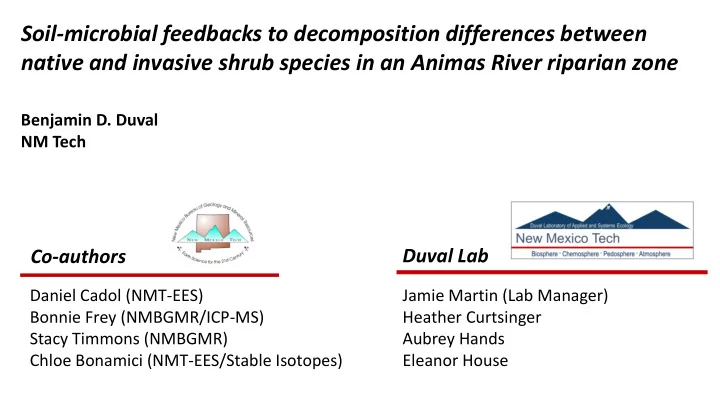

Soil‐microbial feedbacks to decomposition differences between native and invasive shrub species in an Animas River riparian zone Benjamin D. Duval NM Tech Duval Lab Co-authors Daniel Cadol (NMT-EES) Jamie Martin (Lab Manager) Bonnie Frey (NMBGMR/ICP-MS) Heather Curtsinger Stacy Timmons (NMBGMR) Aubrey Hands Chloe Bonamici (NMT-EES/Stable Isotopes) Eleanor House
Bloomfield , NM August, 2017 Christian Science Monitor , August 13, 2015
Gas emissions N 2 O CO 2 Leaf chemistry Soil Exo- Climate enzymes Microbial community Exo- Mass loss enzymes orgN & P Recalcitrant C forms Energy for microbial biomass
Dissolved organic C M + M +
Invasive species/N 2 fixer Elaeagnus = N limitation feedback that favors invasive N 2 O emissions High N litter “home field advantage” N loss? - leaching NO 3 Greater C-processing Soil N enzyme activity?
Populus Native species N 2 O emissions = N mineralization feedback Modest N litter and “home field” advantage N loss - leaching NO 3 Greater N-processing Soil N enzyme activity?
Track sources of energy, C, N into aquatic food webs that feedback to metal cycling Specific aim #1: learn something about different effects of native vs. invasive plants on key ecosystem process Specific aim #2: Importance of litter chemistry vs. soil on gas flux and exo-enzyme activity
Populus 3-month litter-soil incubations Soil Litter Populus Populus “Native” Salix Salix Elaeagnus “Invasion” Tamarix Elaeagnus Tamarix
Populus Soil Litter Tamarix Populus “ Restore ” Salix Salix Elaeagnus “Invasive” Tamarix Elaeagnus Tamarix
Mass Loss (final) Gas flux (weekly) Mass pre vs. post CO 2 = respiration/activity of heterotrophic bacteria, archaea & fungi %C = residual energy N 2 O = N loss from (de)-nitrification 13 C = correlations with microbial biomass
Microbial enzymes drive system-level C:N:P stoichiometry cellulose chitin
Microbial enzymes drive system-level C:N:P stoichiometry exo-enzyme Ecosystem function 1,4 β -glucosidase Releases glucose from cellulose Breaks chitin and chitodextrins 1,4 N-acetyl glucosidase (NAG) Breaks peptide bonds, liberates N Leucine amino peptidase (LAP) Mineralizes organic P into phosphate Acid phosphatase Sinsabaugh et al. 2009 Nature
Populus Litter mass remaining after 90 days soil P S E T range 0.47 0.48 0.44 0.47 P 4% Salix 0.31 0.25 0.24 0.32 S 8% 5% 0.42 0.40 0.40 0.45 E Elaeagnus Tamarix 4% 0.40 0.44 0.42 0.44 T 16% 19% 18% 15% range
1) Most complete decomposition on Salix soil ( R s matches with mass loss) 2) Populus most evenly “active” soils over time
3) No clear home field advantage by faster decomposition 4) Early peaks in R s from Russian olive
soil litter Soil type has greater control on C cycling than litter Mass loss explains both %C and 13 C
Sustained N 2 O emissions from Russian olive Litter greater control on N-loss than soil
Early in succession/decomposition/system development -C limitation to enzyme production - then > physiological need for N and P to maintain cellular stoichiometry
Aztec, New Mexico Species matter (soil effects controlled by plants) Interactions/additive/counter-acting effects of litter community? Argues for inclusion of soil-microbial system information for making “restoration” policy
What else is leaching out from microbial activity during decomposition? Fate of leaves directly entering rivers vs. partially decomposed CPOM? Metal effects on decomposition? Elaeagnus Populus Salix Tamarix
Recommend
More recommend